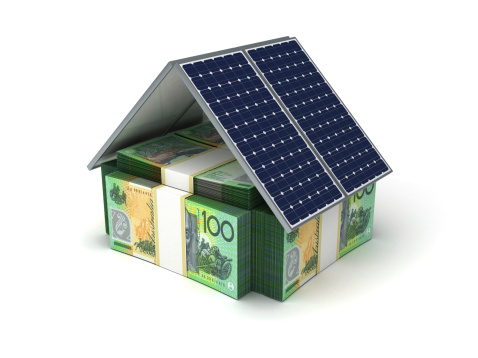Not all energy plans are created equal when it comes to the underlying costs you’ll be paying for powering your home. That’s why it’s important that you’re able to identify a good electricity rate when you see one.
Before we dive into what a ‘good’ rate looks like, it’s worth noting that your total energy costs are broken into two main types of charges. These are electricity usage charges and supply charges, which make up the bulk of your bills. Usage charges are the rate you’re charged for using electricity (per kilowatt hour), while supply charges are the daily rate you’re charged for having electricity supplied to your home.
Electricity rates vary considerably between providers and location, meaning that the same plan in Sydney with low rates may be higher in Coffs Harbour, for example. This is where we can help. In this guide, we’ll give you all the information you need to make an informed decision about what is or isn’t a cheap electricity rate.
On this page:
- What is a good electricity rate?
- The cheapest electricity per kWh
- How much should I pay for electricity usage?
- How much should I pay for electricity supply?
- Am I paying too much for my electricity usage and supply rates?
- Are electricity rates all you should be looking at?
- How to find a good electricity rate
What is a good electricity rate?

If you live in New South Wales, Queensland or Victoria, an electricity usage rate of around 30 to 35 cents per kWh can reasonably be considered a good rate, although lower rates may be available. However, if you live in South Australia, the best you can hope for is around 40 to 45 cents per kWh.
When it comes to electricity supply charges, anything under 110 cents per day can be considered a good rate, no matter where you live. Once again, lower rates may be available in your specific area.
Keep in mind that some retailers compensate for low usage rates with higher supply rates and vice versa. So, to truly find a good deal, you’ll have to find competitive usage and supply charges. If your household uses lots of power, pay particular attention to usage charges, which will make up a higher proportion of your overall energy costs. If you don’t use much power, pay particular attention to the supply charge.
The cheapest electricity per kWh
With competition in the retail energy market fierce, retailers will often change their electricity rates to become more competitive and attract new customers. This means the cheapest rates can change frequently. Below, Canstar Blue has collated the cheapest electricity usage rates on our database per kilowatt hour (kWh) for single rate tariffs across each distribution network in New South Wales, Victoria, south-east Queensland, South Australia, the Australian Capital Territory and Tasmania.
| State | Distribution Network | Lowest Electricity Usage Rate (c/kWh) |
|---|---|---|
| NSW | Ausgrid | 27.1c |
| NSW | Endeavour Energy | 34.3c |
| NSW | Essential Energy | 27.6c |
| VIC | AusNet Services | 27.8c |
| VIC | Citipower | 20.0c |
| VIC | Jemena | 23.4c |
| VIC | Powercor | 23.1c |
| VIC | United Energy | 22.7c |
| QLD | Energex | 25.7c |
| SA | SA Power Networks | 37.2c |
| ACT | Evoenergy | 18.6c |
| TAS | TasNetworks | 24.5c |
Source: www.canstarblue.com.au – 09/10/2023. Based on non-solar only, single rate electricity plans on Canstar’s database. In Queensland, the tariffs are more commonly referred to as tariff 11 (single rate), tariff 31 (controlled load 1), and tariff 33 (controlled load 2). In Tasmania, the tariffs are more commonly referred to as tariff 31 (single rate) and tariff 41 (controlled load).
Compare Electricity Rates and Plans
It’s definitely a good idea to understand what good electricity rates look like, but what about the final cost of powering your home? The table below shows some of the cheapest electricity deals on our database, which therefore come with competitive usage and supply rates.
Here are some of the cheapest published deals from the retailers on our database that include a link to the retailer’s website for further details. These are products from referral partners†. These costs are based on the Ausgrid network in Sydney but prices may vary depending on your circumstances. This comparison assumes general energy usage of 3900kWh/year for a residential customer on a single rate tariff. Please use our comparison tool for a specific comparison in your area. Our database may not cover all deals in your area. As always, check all details of any plan directly with the retailer before making a purchase decision.
Here are some of the cheapest published deals from the retailers on our database that include a link to the retailer’s website for further details. These are products from referral partners†. These costs are based on the Citipower network in Melbourne but prices may vary depending on your circumstances. This comparison assumes general energy usage of 4000kWh/year for a residential customer on a single rate tariff. Please use our comparison tool for a specific comparison in your area. Our database may not cover all deals in your area. As always, check all details of any plan directly with the retailer before making a purchase decision.
Here are some of the cheapest published deals from the retailers on our database that include a link to the retailer’s website for further details. These are products from referral partners†. These costs are based on the Energex network in Brisbane but prices may vary depending on your circumstances. This comparison assumes general energy usage of 4600kWh/year for a residential customer on a single rate tariff. Please use our comparison tool for a specific comparison in your area. Our database may not cover all deals in your area. As always, check all details of any plan directly with the retailer before making a purchase decision.
Here are some of the cheapest published deals from the retailers on our database that include a link to the retailer’s website for further details. These are products from referral partners†. These costs are based on the SA Power network in Adelaide but prices may vary depending on your circumstances. This comparison assumes general energy usage of 4000kWh/year for a residential customer on a single rate tariff. Please use our comparison tool for a specific comparison in your area. Our database may not cover all deals in your area. As always, check all details of any plan directly with the retailer before making a purchase decision.
How much should I be paying for electricity usage?
To offer a guide, Canstar Blue has calculated the average usage rate per kWh for single rate tariffs across each distribution network in New South Wales, Victoria, south-east Queensland, South Australia, the Australian Capital Territory and Tasmania. Prices are shown in cents per kWh.
| State | Distribution Network | Average Electricity Usage Rate (per kWh) |
|---|---|---|
| NSW | Ausgrid | 35.7c/kWh |
| NSW | Endeavour Energy | 37.2c/kWh |
| NSW | Essential Energy | 38.9c/kWh |
| VIC | AusNet Services | 35.8c/kWh |
| VIC | Citipower | 26.7c/kWh |
| VIC | Jemena | 30.7c/kWh |
| VIC | Powercor | 30.4c/kWh |
| VIC | United Energy | 29.3c/kWh |
| QLD | Energex | 31.4c/kWh |
| SA | SA Power Networks | 45.3c/kWh |
| ACT | Evoenergy | 26.6c/kWh |
| TAS | TasNetworks | 29.5c/kWh |
Source: www.canstarblue.com.au – 09/10/2023. Average electricity usage rates based on non-solar only plans on Canstar’s database for each respective rate type (single rate and controlled load), available for annual usages based on the reference usage amounts for each distributor: NSW, VIC, QLD and SA per AER, VIC per Victorian Default Offer, ACT per ICRC, TAS per median usage in the Office of the Tasmanian Regulator’s report, Typical Electricity Customers in Tasmania 2022. In Queensland, the tariffs are more commonly referred to as tariff 11 (single rate), tariff 31 (controlled load 1), and tariff 33 (controlled load 2). In Tasmania, the tariffs are more commonly referred to as tariff 31 (single rate) and tariff 41 (controlled load).
How much should I be paying for electricity supply?
Much like your usage rate, electricity supply charges will differ between areas and retailers. What you may notice is that some states (we’re looking at you SA) have low electricity supply rates, but much higher usage rates. If you’re a small household with modest energy usage, supply charges will account for a larger portion of your bill, so keep a close eye when you go to compare prices.
To offer a guide, Canstar Blue has calculated the average supply charge in cents per day (c/day) for single rate tariffs across each distribution network in New South Wales, Victoria, south-east Queensland, South Australia, the Australian Capital Territory and Tasmania.
| State | Distribution Network | Average Electricity Supply Charge (c/day) |
|---|---|---|
| NSW | Ausgrid | 98.4c |
| NSW | Endeavour Energy | 105.3c |
| NSW | Essential Energy | 172.9c |
| VIC | AusNet Services | 123.6c |
| VIC | Citipower | 108.1c |
| VIC | Jemena | 107.4c |
| VIC | Powercor | 122.3c |
| VIC | United Energy | 100.8c |
| QLD | Energex | 121.3c |
| SA | SA Power Networks | 114.4c |
| ACT | Evoenergy | 107.9c |
| TAS | TasNetworks | 108.7c |
Source: www.canstarblue.com.au – 09/10/2023. Average electricity usage rates based on non-solar only plans on Canstar’s database for each respective rate type (single rate and controlled load), available for annual usages based on the reference usage amounts for each distributor: NSW, VIC, QLD and SA per AER, VIC per Victorian Default Offer, ACT per ICRC, TAS per median usage in the Office of the Tasmanian Regulator’s report, Typical Electricity Customers in Tasmania 2022. In Queensland, the tariffs are more commonly referred to as tariff 11 (single rate), tariff 31 (controlled load 1), and tariff 33 (controlled load 2). In Tasmania, the tariffs are more commonly referred to as tariff 31 (single rate) and tariff 41 (controlled load).
Am I paying too much for my electricity usage and supply rates?
Knowing your electricity usage and supply rates is one way to determine whether you could be paying too much for power. But it can be tricky to determine the actual impact of these costs if you are unfamiliar with your energy usage amounts. By way of a rough guide, Canstar Blue has also calculated the average quarterly energy costs, including both usage and supply charges, for each distribution network in NSW, VIC, SEQ, SA, the ACT and TAS. Please note, these costs have been calculated to a specific quarterly usage amount, using the average rates presented in the tables below above. Actual costs may differ significantly on your final energy bill.
| State | Distribution Network | Average Quarterly Energy Usage | Average Quarterly Energy Costs |
|---|---|---|---|
| NSW | Ausgrid | 978kWh | $438.94 |
| NSW | Endeavour Energy | 1228kWh | $552.90 |
| NSW | Essential Energy | 1153kWh | $606.29 |
| VIC | AusNet Services | 1000kWh | $470.79 |
| VIC | Citipower | 100okWh | $365.64 |
| VIC | Jemena | 1000kWh | $405.00 |
| VIC | Powercor | 1000kWh | $415.60 |
| VIC | United Energy | 1000kWh | $384.98 |
| QLD | Energex | 1153kWh | $472.73 |
| SA | SA Power Networks | 1003kWh | $558.75 |
| ACT | Evoenergy | 1525kWh | $504.11 |
| TAS | TasNetworks | 737kWh | $316.60 |
Source: www.canstarblue.com.au – 09/10/2023. Electricity usage cost estimates based on the average usage rates from the above tables. Scenario based on a customer who uses the same amount of electricity as the reference annual usage for a single rate plan from each distributor. Based on a 365 day year.
Are electricity rates all you should be looking at?

Absolutely not. If electricity rates are the only factors you’re mindful of, then you could be missing out somewhere else. It would be like buying a car straight from the dealership at the asking price without seeking any extras or customer incentives. In the world of energy, it’s a similar situation, where price alone is just the starting point. Here’s a few features to look out for in an energy plan to get the best overall value.
- Discounts: Typically apply to usage or usage and supply rates for a period of time. Some discounts may only apply if certain criteria is satisfied, like paying on time or setting up direct debit payments.
- Bill credits: Some retailers offer credits off bills to customers who sign up online or bundle their utilities with the same company, such as electricity and gas, or even internet. Energy bill credits are either a once-off or ongoing feature.
- Rewards programs: Energy providers like AGL, Alinta Energy and Lumo Energy offer exclusive deals to customers in partnerships with various companies. Some rewards include frequent flyer points, shopping vouchers and movie tickets.
- Entertainment packages: Whether it’s a subscription to a sports streaming service or tickets to a zoo, many entertainment features can be unlocked with some plans. Keep in mind these offers change quite frequently.
- Customer service: Last but certainly not least, don’t sacrifice customer service as you may regret it should you ever need to get in contact. Look at call centre hour availability as well as smartphone apps and website functionality.
How to find a good electricity rate
Hopefully we’ve cleared up any doubts about energy rates and you’re in a better position to find a deal that’ll help keep electricity costs down. If you’re still a little overwhelmed, try jumping into our comparison tool. Best of all, it’s free to use and we won’t ask for your phone number, allowing you to browse a range of electricity rates from more than 20 electricity providers.
Image credit: Rodolfo Clix/Pexels



Share this article